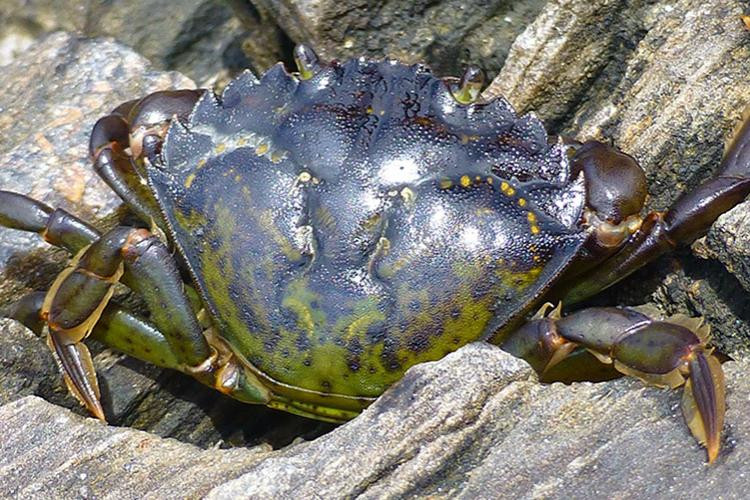
Scientists are on the lookout for an invasive crab species expected to move north into Alaskan waters. This year in Southeast Alaska, they added a new tool to the monitoring effort for European green crab, which is a threat to the state’s shellfish and salmon.
European green crab or shore crab have been expanding their range north along the Pacific coast. But this year they were discovered just south of the Alaskan border.
“This Haida Gwaii occurrence last summer puts them very close to us,” said Linda Shaw, invasive species coordinator for the Alaska regional office of NOAA Fisheries. “I really wish I could say we don’t expect them, but prudence dictates that we say, yes, we think it’s a matter of when, not if.”
In July, natural resources managers found male and female adult green crab in Haida Gwaii, formerly called the Queen Charlotte Islands.
The species is native to northern Europe but has expanded its range to North and South America, Africa, Asia and Australia. The crab species was first found on the east coast of the U.S. in 1817 and the west coast in in San Francisco in the 1980s. Initially they may have been transported in ship ballast or by other human means. But some of the northward expansion in the Pacific may be drifting young crab on oceans currents.
Shaw said this animal ranks highly on the list of invasive threats for Alaska.
“They’re one of the top, at least marine, invasive species that we’re concerned about, and we’ve been tracking them for many years because they’ve been on the west coast already. They’re in Oregon and Washington and have been moving up the coast of British Columbia,” Shaw said.
On the east coast, these hardy crustaceans are known as aggressive eaters and have meant millions of dollars lost in fisheries for clams, mussels and scallops. The crab are destructive to eelgrass beds, which are important to young fish. They’re also known to eat juvenile salmon and could compete with native Dungeness crab.

These green crab have expanded their range northward during times of warmer water conditions from El Nino events. Scientific models predict warmer water from climate change could also help the spread of the species.
The typical way to monitor for this invader is using fish traps in targeted spots. But this past year Shaw and Alaska Sea Grant fellow Meredith Pochardt came up with a plan to combine trapping and water sampling in multiple spots. The water testing could produce environmental DNA, left behind by the crab in skin, shell or excrement. Scientists describe this eDNA, as its called, like a biological fingerprint. Shaw said this is a relatively new method that seems well suited to monitoring for invasive species.
“So maybe we have a broader net to cast,” she said. “Just collecting the water samples, which are filtered down, and then the eDNA is analyzed for the potential presence of that organism.”
That wider net helps on Alaska’s expansive coastline. But the plans for the expanded monitoring were derailed by travel restrictions from the global pandemic. Instead other scientists working at Little Port Walter on southern Baranof Island south of Sitka obtained the testing equipment and took the first water samples for green crab. Results aren’t back yet from that testing. Shaw cautioned that even if DNA is detected, follow up trapping is still needed to confirm the presence of that species in Alaska.
The scientists also secured funding to work with the Metlakatla Indian Community to join the monitoring effort.
“They are positioned ideally down there on Annette Island close to our southern Southeast Alaska border to be able to intercept green crab that might be coming north towards Alaska. And they were very interested in this project.”
The Alaska Department of Fish and Game provided fish traps that were sent to Metlakatla and set in several spots. No crab turned up there, or in traps set at Little Port Walter. The eDNA water sampling could start up in Metlakatla in 2021 and scientists may look to add other spots. They plan a full sampling season next April through September.
The Link LonkDecember 18, 2020 at 03:06AM
https://ift.tt/3rbbrXE
Scientists look for invasive crab 'fingerprint' in Alaska waters - KTOO
https://ift.tt/2MkGRbk
Crab

No comments:
Post a Comment